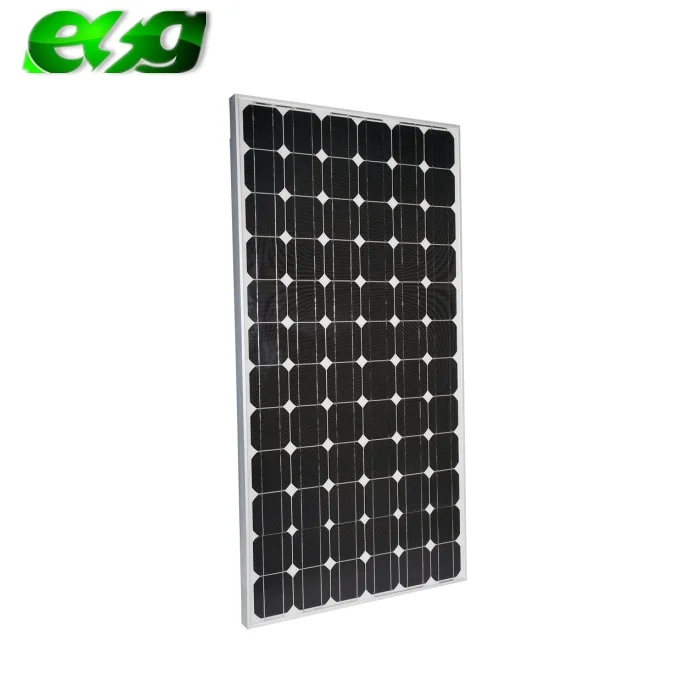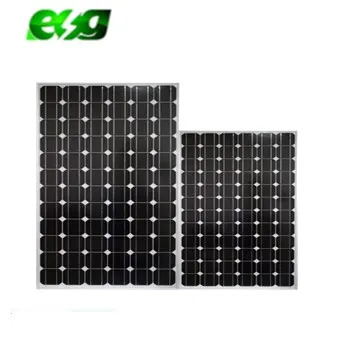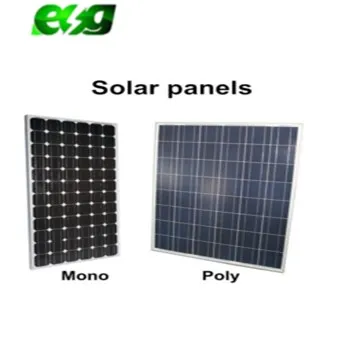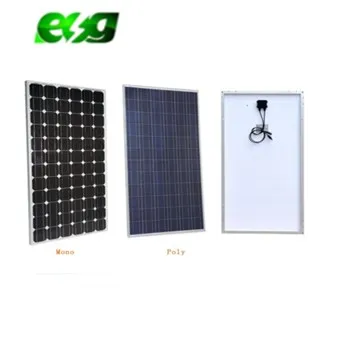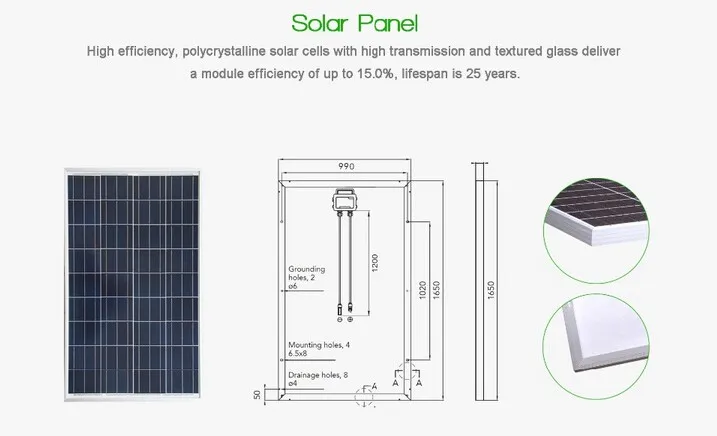China best PV supplier ESG MONO 260W 250 watt 300 Watt photovoltaic solar panel
High Efficiency TUV Monocrystalline Solar panel 300w
Solar Panel Structure

Technic Parameter for Soalr Panel

Applications

Rural and island electrification
Commercial/industrial building roof-top systems
Residential roof-top system
Solar street lamp
Other industrial and commercial applications
Quality and Safety
Rigorous quality control meeting the highest international standards
High-transmissivity low-iron tempered glass, strong aluminium frame
Using UV-resistant silicon
Features
Aesthetic appearance with excellent efficiency based on innovative
photovoltaic technologies
Strong frame, passing mechanical load test of 5400Pa, instead of the normal
2400Pa,to withstand heavier snow load and higher wind-pressure
Warranties
10 years limited product warranty
15 years at 90% of the minimal rated power output
25 years at 80% of the minimal rated power output
Our Solar Panel Production Chain

Our Most Important Material for Solar Panel


Solar Panel Life Curve

Solar Panel type (MONO or Poly) for you choose

Alibaba Direct factory sale price per watt solar panels
ESG Solar Panel
1. Packaging : carton box & wooden pallet. --- One Solar Panel will be in one carton paper. --- Easy for distribution under our (solar panel price india)
2. Delivery Detail: 10-15working days after order confirmed

ESG Cheap 3W to 300W Mono solar panel 100W 150W 200W 250W monocrystalline solar PV panels
Why Choose ESG Solar panel ?
1), CE,CMA,CNAS,ISO,SGS,CGC
2),30 years experience before was Sino-Japanese joint venture government.
3),Fast Delivery.(7-15days)
4),Complete Product Chain.(High Quality &Favorable Price )
5) Accept any form of payment.
6), Free sample for you testing.

A-Grade MONO 300w solar panel for Off-grid solar stem
ESG New Energy Technology Co. Ltd Committed to engage in off-grid system, We are producing batteries, pure sine wave inverter,solar controller , wind and solar power generation system production, We have a production line and scientific quality management system. Development and sales of high-tech enterprises.
China Manufacturer with 30 years experience , we have 2 brands in China. ESG was established in 2013, a newest brand are specialized in solve green energy project.
high-quality, high efficiency, Adapt to market demand, the research management team,and with the domestic institutions of higher learning, scientificresearch institutions to establish a broad and close relations of cooperation, thus ensuring the company sustainable development and product development of advanced technology.
ESG New Energy Technology Co. Ltd., integrity, strength and quality of products recognized by the industry.
Welcome friends to visit, guidance and business negotiation.

SG 100W Mono solar panel in China with full certificate
Our Certificate and testing report for solar panel

Our Work Team for solar panel

Our Project

Contact Information

Gentle hint:
Communication first, then place the order
There are more surprises awaiting you!!!! H ESG Cheap 3W to 300W Mono solar panel 100W 150W 200W 250W monocrystalline solar PV panels
Power Electronics for Renewable Resource
SOLAR ENERGY
I. Solar Energy Background
The earliest use of solar energy was noted in the 7th century BC, when a magnifying glass was used to concentrate the solar rays to light fire. Since then, solar energy has found numerous applications. The most significant discovery in the field of photovoltaics was made by the French scientist Edmund Becquerel in 1839. While experimenting with an electrolytic cell made of two different metal electrodes placed in an electrical conducting solution, he observed that electricity generation increased with exposure to light. Following this discovery, scientists from Europe and the USA concentrated their efforts on researching solar energy.
Later in 1954, the first commercial silicon photovoltaic (PV) cells were invented at Bell Labs, USA. These solar cells were capable of generating enough solar power to run everyday use electrical equipment. Bell labs then went on to produce 6% efficient and then later 11% efficient PV cells. Much of the research in the 1950s and the 1960s were concentrated in finding more efficient solar cells. Researchers in the field experimented with different materials like silicon wafers, cadmium sulphide, selenium, etc, to achieve higher efficiency. During this time photovoltaic cells were being developed for earth orbiting satellites. In 1964 NASA launched the first Nimbus spacecraft – a satellite powered by a 470 W photovoltaic array.
Later in the 1980s solar power became a popular energy source for consumer electronics devices such as calculators, watches, radios and battery charges. During this same period photovoltaics started to find applications in residential and small commercial complexes. Rooftop applications were a common trend during this time. Currently, solar power is the most popular form of renewable energy source for residential use.
Worldwide, photovoltaics account for 500 MW of power generation with an annual growth rate greater than 20%. In the near future photovoltaic power is expected to become more cost effective and will be almost price competitive with traditional sources of energy. With development and breakthrough in new cell materials and power electronics technologies solar power can prove to be an efficient, environmental friendly and safe means of power.
II. SOLAR PANEL AND IT’S BENEFIT TO MANKIND?
Nowadays, there are plenty of innovations in technology that makes our life comfortable and productive. Actually One of this is the invention was invented long ago but not that yet popular. It is the solar panel that I am talking to which converts sunlight into useful renewable energy.??
Solar panel is a device that makes use of the enormous and unlimited resource of sunlight that the sun gives. We will never worry that electricity will run off or there will be power shortage since sun is very consistent in giving us light energy. It generates power to every household and businesses that are using the solar panel especially those in remote areas.?
Solar panel has no moving mechanical parts so there will be no worries for us to replace, maintain or fix and check the device. It is also the cheapest energy generator rather than subscribing in power companies and pay monthly bills.?
The solar panels also became the number one solution for places where the main problem is electricity or power shortage. And if weight against other renewable energy generators the solar panel is the only the device that produces electricity silently and modestly.?
The solar panel can be place anywhere as long as there is sunlight. No need also to worry about the place to set those solar panels for it could also be placed in your rooftop. The only thing you should consider is the size of the solar panel. It must be proportional to the power you needed in powering up your house. Small solar panels generates little electricity while bigger solar panels generates more powerful electricity.??
Best example to give in using the solar panel is the satellites. Satellites are situated outside our planet with no connection of electrical wiring from Earth. The only power generator that could use there is solar panels.?
III. Two Types of Solar Energy Devices
·SOLAR THERMAL CONVERTERS
Solar thermal converters: Solar thermal converters are the oldest systems of collecting energy from the sun. Thermal converter use dark colored panels and sometimes reflector panels placed on areas such as rooftops, to absorb the heat from the sun.
The panels collect heat which in turn heats fluid, such as oil or water. As this heated fluid travels through the panel, it absorbs the sun’s heat energy and produces hot liquid, or even steam. If steam is produced, the steam turns a turbine, creating rotational energy that is converted into electricity by a generator.
As thermal converters need heat to create energy and require warmer temperatures, they work best in areas closer to the equator.
·SOLAR PHOTOVOLTAIC CONVERTERS
Solar photovoltaic (PV) converters: Solar PV converters convert sunlight energy into electricity. A typical PV panel consists of two or more thin layers of semi-conducting material, which is commonly silicon. PV cells are connected together and encapsulated, to form a module or panel. Incoming solar rays are captured by the solar panels.
When light strikes the silicon, it produces electrons that are conducted away by a metallic grid as direct current (DC). This is then sent through an inverter and converted into alternating current (AC) electricity for use in the home, or at school.
IV. HOW A PV SYSTEM WORKS
Simply put, PV systems are like any other electrical power generating systems, just the equipment used is different than that used for conventional electromechanical generating systems. However, the principles of operation and interfacing with other electrical systems remain the same, and are guided by a well-established body of electrical codes and standards.
Although a PV array produces power when exposed to sunlight, a number of other components are required to properly conduct, control, convert, distribute, and store the energy produced by the array.
Depending on the functional and operational requirements of the system, the specific components required may include major components such as a DC-AC power inverter, battery bank, system and battery controller, auxiliary energy sources and sometimes the specified electrical load (appliances). In addition, an assortment of balance of system (BOS) hardware, including wiring, overcurrent, surge protection and disconnect devices, and other power processing equipment. Figure 3 show a basic diagram of a photovoltaic system and the relationship of individual components.
V. TYPES OF SYSTEMS
Photovoltaic power systems are generally classified according to their functional and operational requirements, their component configurations, and how the equipment is connected to other power sources and electrical loads. The two principal classifications are grid-connected or utility-interactive systems and stand-alone systems. Photovoltaic systems can be designed to provide DC and/or AC power service, can operate interconnected with or independent of the utility grid, and can be connected with other energy sources and energy storage systems.
Grid-Connected or Utility-Interactive PV Systems
Grid-connected or utility-interactive PV systems are designed to operate in parallel with and interconnected with the electric utility grid. The primary component in grid-connected PV systems is the inverter, or power conditioning unit (PCU). The PCU converts the DC power produced by the PV array into AC power consistent with the voltage and power quality requirements of the utility grid, and automatically stops supplying power to the grid when the utility grid is not energized. A bi-directional interface is made between the PV system AC output circuits and the electric utility network, typically at an on-site distribution panel or service entrance. This allows the AC power produced by the PV system to either supply on-site electrical loads, or to back-feed the grid when the PV system output is greater than the on-site load demand. At night and during other periods when the electrical loads are greater than the PV system output, the balance of power required by the loads is received from the electric utility This safety feature is required in all grid-connected PV systems, and ensures that the PV system will not continue to operate and feed back into the utility grid when the grid is down for service or repair.
Stand-Alone Photovoltaic Systems
Stand-alone PV systems are designed to operate independent of the electric utility grid, and are generally designed and sized to supply certain DC and/or AC electrical loads. These types of systems may be powered by a PV array only, or may use wind, an engine-generator or utility power as an auxiliary power source in what is called a PV-hybrid system. The simplest type of stand-alone PV system is a direct-coupled system, where the DC output of a PV module or array is directly connected to a DC load. Since there is no electrical energy storage (batteries) in direct-coupled systems, the load only operates during sunlight hours, making these designs suitable for common applications such as ventilation fans, water pumps, and small circulation pumps for solar thermal water heating systems. Matching the impedance of the electrical load to the maximum power output of the PV array is a critical part of designing well-performing direct-coupled system. For certain loads such as positive-displacement water pumps, a type of electronic DC-DC converter, called a maximum power point tracker (MPPT), is used between the array and load to help better utilize the available array maximum power output.
In many stand-alone PV systems, batteries are used for energy storage. Figure 6 shows a diagram of a typical stand-alone PV system powering DC and AC loads. Figure 7 shows how a typical PV hybrid system might be configured.
VI. CHARGE CONTROLLERS
A charge controller, or charge regulator is similar to the voltage regulator in your car. It regulates the voltage and current coming from the solar panels going to the battery. Most "12 volt" panels put out about 16 to 20 volts, so if there is no regulation the batteries will be damaged from overcharging. Most batteries need around 14 to 14.5 volts to get fully charged.
THREE TYPES OF CHARGE CONTROLLERS
1. Series Charge Regulators
In the series charge controller, the switch S1 disconnects the PV generator when a predefined battery voltage is achieved. When the voltage falls below the discharge limit, the load is disconnected from the battery to avoid deep discharge beyond the limit. The main problem associated with this type of controller is the losses associated with the switches. This extra power loss has to come from the PV power, and this can be quite significant. Bipolar transistors, MOSFETs, or relays are used as the switches.
2. Shunt Charge Regulators
In this type, when the battery is fully charged the PV generator is short-circuited using an electronic switch (S1). Unlike series controllers, this method works more efficiently even when the battery is completely discharged, as the short-circuit switch need not be activated until the battery is fully discharged.
The blocking diode prevents short-circuiting of the battery. Shunt charge regulators are used for small PV applications (less than 20 A).
Deep-discharge protection is used to protect the battery against deep discharge. When the battery voltage reaches below the minimum set point for the deep-discharge limit, switch S2 disconnects the load. Simple series and shunt regulators allow only relatively coarse adjustment of the current flow and seldom meet the exact requirements of PV systems.
3. Dc–dc Converter Type Charge Regulators
Switch mode dc-to-dc converters are used to match the output of a PV generator to a variable load. There are various types of dc– dc converters:
VII. SIMPLE PV CELL AND RESISTIVE LOAD
Photovoltaic cells are usually manufactured from silicon although other materials can also be used. n-type semiconductors are made of crystalline silicon that has been “doped” with tiny quantities of an impurity (usually phosphorous) in such a way that the doped material possesses a surplus of free electrons. On the other hand, p-type semiconductors are also made from crystalline silicon, but they are doped with very small amounts of a different impurity (usually boron) which causes the material to have a deficit of free electrons. Combination of these two dissimilar semiconductors produces an n-p junction, which sets up an electric field in the region of the junction. Such a set up will cause negatively (positively) charged particles to move in one direction (in the opposite direction).
Light is composed of a steam of tiny energy particles called photons, and if photons of a suitable wavelength fall within the p-n junction, then they can transfer their energy to some of the electrons in the material so prompting them to a higher energy level. When the p-n junction is formed, some of the electrons in the immediate vicinity of the junction are attracted from the n-type layer to combine with holes on the nearby p-type layer. Similarly, holes on the p-type layer near the junction are attracted to combine with electrons on the nearby n-type layer. Hence, the net effect is to set up around the junction a layer on the n-type semiconductor that has more positive charges than it would otherwise have.
VIII. Advantages and Disadvantages of Solar Energy
ADVANTAGES:
·Solar energy is clean.
·More cheaper than electric heating.
·Solar energy is a great alternative because it provides you with anything from heating water, electricity, and even cooking.
·If you live in a remote area where there are no power-lines solar energy can be the solution.
·Another great use of solar energy is for desalination in areas where fresh, drinkable water is scarce.?
DISADVANTAGES:
·The main disadvantage of solar energy is that it’s dilute.
·One big disadvantage is that you need the sun rays to make use of solar energy.
·Lastly the sun only shines during the day.?
We have more categories for you. lf you can't find the products you want above,just fill in the form and tell us whatproducts you want to import from China.


